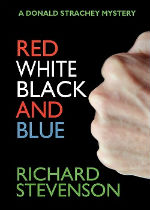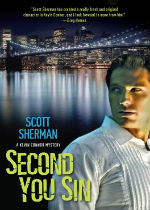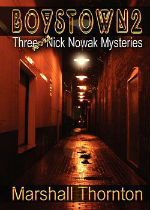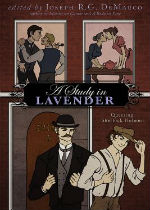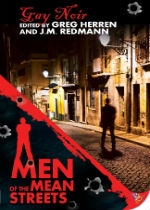GunnShots: Fall 2011
Author: Drewey Wayne Gunn
November 2, 2011
The end of a hot and extremely dry summer brought a number of enjoyable distractions. Richard Stevenson’s latest Don Strachey case shows author and P.I. back in top form, thirty years after their debut. There were second novels from Joseph R.G. DeMarco and Scott Sherman. Jordan Castillo Price and Andrea Speed continued their alternate universe mystery series, joined by newcomer Stephen Osborne. I am happy to report that I was part of Cheyenne Publishing’s decision to bring Ruth Sims’s pioneering YA Pride Pack mysteries back into print. Two authors — Michael Gouda and Marshall Thornton — brought off that rarity: single-author short story collections. And two anthologies of all new crime writing appeared, one edited by DeMarco and the other by Greg Herren and J.M. Redmann. Plus, the excellent film adaptation of Ken Bruen’s comic thriller Blitz became available onDVD.
Don Strachey Rides Again
Don Strachey returns for his twelfth case in Richard Stevenson’s Red White Black and Blue. This time he takes on such a dysfunctional and hypocritical group ofAlbany legislators that readers
would roll their eyes, were it not for the fact that current events inWashington outdid Richard Stevenson’s imagination at its wildest even as his novel was in press. I finished an advance copy just two days before the nation nearly defaulted, appreciating the author’s perspicacity with each turn of the page. The novel is among the very best in this long-running and always distinguished gay mystery series.
The initial problem Don is called upon to solve seems simple: Is the leading candidate for the position of governor in New York’s upcoming Democratic primary a closeted homosexual who seeks out vulnerable youths in order to physically and emotionally abuse them, having even driven one partner to suicide? If so, his chief political rival in the party wants the goods on him in order to expose his treacherous character — and incidentally put himself in a stronger position in the final race against the Republicans’ almost certain Tea Party candidate.
What Don does not anticipate about the investigation is that he will be repeatedly roughed up, but never terribly damaged, by a squad of Serbian goons transplanted to American soil. How is it that they seem to know his every move? Which, if any, of the various rival factions has hired them? And how is it that they have Don’s number so accurately that even he has to acknowledge someone is manipulating him? There may be a murder in the past, even, but this is a political thriller unlike most. As he has done before, Stevenson leavens an atmosphere approaching noir with incidents that are downright farcical — all served up with Don’s satirical wisecracks, which invariably hit the various idols he skewers dead center.
It is downright refreshing to have a hero who must rapidly be approaching his creator’s own age but who becomes more liberal the older he gets. Here’s one of Don’s typical observations, made just two pages into the story: “A healthy democracy needs two parties both working for the common good. Not one dedicated to screwing the poor and the middle class and the other one busy screwing itself every chance it gets” — as Don sums up later on, “the glamorous world of democracy-at-work savagery.” One of the cynical politicians dismisses him as “a sentimentalist.”
Political issues have informed the series from its inception. The other great theme that moves in and out of the novels is the author’s empathy for abused gays, particularly those abused by their own parents. It strikes me that whenever these two themes converge, we find Stevenson writing at the top of his skill. I don’t really understand people whose psychic makeup leads them to seek abuse, even after all the examples I encountered in forty years as a teacher. But they haunt me, just as the young adults who were manipulated by the vicious politician remain stronger in my memory upon finishing the book than do other characters. They join the sad victims in the author’s Death Trick (1981), Third Man Out (1992), and Shock to the System (1995).
Timmy, Don’s partner and a legislator’s aide, remains at his Jesuit-educated best. A character new to the series — computer hacker extraordinaire, Bud Giannopolous, with his own peculiar sense of the absurdity of it all — aids and abets Don’s more flexible morality. The rest of the characters are an often comical, often frightening cross-section of American types, mostly whites at their screwiest best and worst, with a Walmart fanatic fitting both extremes. I don’t think it’s a spoiler to say that Don finally emerges from their midst victorious, having wheeled and dealed with enough cunning to ensure Andrew Cuomo becoming the actual Democratic Party candidate. Now, given New York’s approval of same-sex marriages, it will be interesting to see if Don and Timmy officially tie the knot in the next novel.
Red White Black and Blue
by Richard Stevenson
MLR Press
Paperback, 9781609203635, 224pp
June 2011
Second Novels in a Series
Second novels are notoriously difficult to pull off. Perhaps this is even truer for the second in a series. Therefore it was a pleasure to discover that I enjoyed Joseph DeMarco’s second entry in
the Marco Fontana, P.I., series much more than I did the first. A classic story of murder in Philadelphia, I had less trouble keeping up with the large cast of characters. Whereas the first novel looks at corruption within the Church in a sort of Dan Brown way, this one seems more timely in its examination of corruption in politics. It is election time, and candidates of various stripes are out for the vote, even courting potential gay and lesbian support. Some of the means they use, however, do not bear scrutiny.
At first the murders would seem to have nothing to do with politics. Marco’s friend Brad Lopes, a masseur with talented fingers, is killed, along with a business contractor — the latter in Brad’s spa, Brad himself on the street. Then a freelance news reporter turns up drowned in the Schuylkill River. He was investigating a possible jury tampering case. Is it merely coincidental that Brad just served on a jury? What difference could it possibly make since the defendant was found guilty and sentenced to prison? Then there is the question, how could Brad have afforded the extensive remodeling he has undertaken in his spa? Seeking answers, Marco moves among a singularly high number of real and probable closet cases, the latter including handsome newcomer to the Philly police department, Detective Dae Shim. Marco too faces an unsavory set of gangsters transplanted from Eastern Europe, who rival and possibly outstrip the Mafia in their gristliness.
Marco’s personal life is the only downer in the novel. His inability to commit causes his close associate, Anton, to turn to a new stripper as a companion. (Marco is a dual business owner: his investigation firm and his troop of male strippers.) After a while Marco’s jealousy becomes irritating. I hope he matures in his third case.
New York City male hustler and amateur sleuth Kevin Connor returns in Scott Sherman’s Second
You Sin to come face to face with another ruthless killer. The results are even less a conventional murder mystery than his first outing. Most of the novel’s several plots arise from personal problems, generally comical in nature. The plucky hero must use his ingenuity and often his sexual skills to resolve them — once he remembers to take his medication for attention deficit disorder. The supporting cast in the first novel returns: his best friend, Freddy; his not-ready-to-commit boyfriend, Tony the cop; the agoraphobic computer hacker, Marc; his stereotypical Jewish mother — along with some randy newcomers. Not until halfway through the novel does Kevin become convinced that someone really is killing fellow hustlers and decide to take action. Even then, other events have a way of intruding before the perpetrator is caught. Along the way the worlds of fashion and of television road shows become targets for campy satire.
A Body on Pine
By Joseph R.G. DeMarco
Lethe Press
Paperback, 9781590213452, 464pp
April 2011
Second You Sin
By Scott Sherman
Kensington Books
Paperback, 9780758266514, 314pp
September 2011
Single Author Collections of Short Stories
I have remarked before how few collections of gay mystery and crime stories by a single author exist. Their number is now enlarged by two authors well worth checking out: Michael Gouda and Marshall Thornton. Their books share similarities. In both the individual cases are solved to the reader’s satisfaction. But in each, as one moves from story to story, the reader gets a larger sense of the private investigator’s life, and certain characters recur. Sex must sell these days — or at least get one’s book published. Both authors periodically stop the progress of their stories for extended sex scenes. At least, they come across as authentic.Thornton in particular registers quite accurately what can happen to the male psyche when the penis seizes control of it.
Gouda’s Crimes of Passion has twelve stories. They cover a wide variety of cases, all involving gays: arson, bent policemen, blackmail, cheating lovers, death threats, homophobia, missing people, murder, pedophile rings, and even a fight against real estate developers and an alleged abduction by aliens. Woven through the investigations is the off-and-on relationship between its London private investigator, Tim Silvain, and advertising publicist Paul Massingham. Paul wants monogamy; Tim wants variety. I enjoyed the stories, particularly the more offbeat ones, but the book as a whole does not match Gouda’s achievement in last year’s crime novel, Crook. I wanted the same fulfilling complexity that that book offers.
In this way, Thornton’s three-volume Boystown stories are more satisfying. The eight stories are set in Chicago during the two-year period 1981-1982, when our lives inexorably changed. Years earlier Nick Nowak left the Chicago police after he and his lover, Daniel Laverty, were mugged, and
Daniel left him because of the way he mishandled the situation. Now a private investigator, Nick’s cases resemble Tim’s: arson, missing people, attempted and real murders. But they are more
involved, and though each is solved in the end, the resolution is sometimes messy — one criminal not being brought to justice until several cases later, another escaping altogether.
Characters return, and the whole achieves the status of a traditional novel. While working a case, Mike becomes involved with closeted police officer Bert Harker. Neither man will quite commit, Harker out of fear of leaving the closet, Mike because he still carries the torch for Daniel. Mike continues his promiscuous ways. He pays little attention to the rumors that begin swirling about some mysterious disease targeting gays. But when Harker develops a mysterious series of fevers and other ailments, his life suddenly becomes more complicated. I’m still not sure what I think about the very ending. But the fact that it bothers me pays tribute to the emotions the stories evoke.
Crimes of Passion
By Michael Gouda
MLRPress
Paperback, 9781608203987, 340pp
July 2011
Boystown: Three Nick Nowak Mysteries
Boystown 2: Three More Nick Nowak Mysteries
Boystown 3: Two Nick Nowak Novellas
By Marshall Thornton
Torquere Press
Paperback, 9781610402330,-354,-408, 200pp each
July 2011
New Anthologies
Just as there have been few single-author collections of gay crime stories, there have been even fewer anthologies with stories by multiple authors. In 1989 Michael Nava edited Finale, a collection of eight crime and mystery stories. The next collection did not appear until 2002, when Peter Burton brought out Bend Sinister, an anthology of twenty-eight crime stories, followed by his Death Comes Easy in 2003, with a further twenty-nine — no traditional mysteries in the lot. In 2007 Sean Meriwether and Greg Wharton edited Men of Mystery, with sixteen stories, all with high erotic content; it was paired with Women of Mystery, edited by Katherine V.Forest. Now two new gay anthologies (and one lesbian) join their ranks.
Editor Joseph R.G. DeMarco has assembled eleven new stories connected in some way to the world of Sherlock Holmes: A Study in Lavender. All the cases involve homosexuals (a term barely coming into use at the end of the 19th century), but only five actually out Holmes and only one outs Watson. Even then, the model is more the one found in Billy Wilder and I.A. Diamond’s film script The Private Life of Sherlock Holmes and Mark Gatiss and Steven Moffat’s teleplays for the BBC’s Sherlock than the randy Holmes portrayed by Larry Townsend or Steven Saylor (as Aaron Travis) in their erotic recastings (and even less the marvelous burlesque of Holmes in a 1975 porn video, The American Adventures of Surelick Holmes).
As one would expect, most of the stories follow the Doyle’s formula. In one Sherlock puts off the Cleveland Street scandal for a bit longer. Another involves Sherlock’s homosexual brother, Mycroft. Six involve the problems same-sex lovers, both men and women, have. Of these William P. Coleman’s novella, “The Well-Educated Young Man,” perhaps because of its greater length, makes the strongest impression. It recounts Holmes and Watson’s encounter with a young male prostitute who has a crush on the detective and who later turns to him for help when his lover is kidnapped. During the course of the story, Watson is enlightened about the psychological complexities of child abuse involving a gay child, the ways homosexuals recognize each other, the particular gifts granted a detective who is gay, and the reasons Holmes holds back on disclosing his thinking processes to him. Watson, in turn, has a number of interesting things to say about writing.
Otherwise, these stories tend to merge in my memory. The ones that remain distinct are the three that diverge from the formula. A whodunit narrated by Inspector Lestrade reveals that not only he but others in Scotland Yard are homosexual. As he seeks to discover who murdered his lover, a constable, he constantly thinks about Holmes’s methods. The editor’s own story, a whodunit set during the preparations to film the last Hollywood collaboration between actors Basil Rathbone and Nigel Bruce, has them bumbling through their roles as they seek to solve the murder of a child actor. The most striking is Ruth Sims’s tale of a British serial killer who is, for a while, Doyle’s secretary and even contributes ideas for the stories. Told by the killer himself, it is the only non-mystery in the lot and could as easily fit into the second anthology as it does this one.
Outing Holmes, by the way, seems to be something of a trend right now. T. D. McKinney and Terry Wylis have just published Kissing Sherlock Holmes (Amber Quill Press), a bit of M/M fluff, and Barry Lowe has brought out The Framing of Dorian Gray (loveyoudivine ebook), which I have not seen. Also, Rohase Piercy’s My Dearest Holmes (1988), another early work that queered Holmes, is once again available (BookSurge Publishing).
Greg Herren and J.M. Redmann collected fourteen new stories for their collection Men of the
Mean Streets. (There is also a companion volume, Women of the Mean Streets.) Labeled Gay Noir on the cover, Herren in his introduction indicates that the adventurous editors let each of the contributors define for her or himself what constitutes noir. The spirit of Cain and Highsmith reigns over the results more than does that of Chandler — an irony given that he provides the title for the anthology. Moreover, in the course of the stories, a twist occurs with five of the seven words on the cover, only “of the” escaping some kind of redefinition. We are treated to eight crime stories and six mysteries that involve metaphysics, science fiction, gender blur, and gentle parody along with more traditional approaches. I get the impression that most of the writers are slumming rather than being true inhabitants of the world of noir. Their hearts don’t seem to be in the stories.
In The Oxford Companion to Crime and Mystery Writing (edited by Rosemary Herbert et al., 1999), James L. Traylor and Max Allan Collins write: “Fiction Noir depicts the controlled depravity and existential absurdities faced by men and women caught in a web of random violence, amorality, and lust for sex and money.” That certainly sums up the majority of these works. Many of the contributors are established gay mystery writers: Josh Aterovis, Rob Byrnes, Michael Thomas Ford, Greg Herren, Felice Picano, Neil Plakcy, Jeffrey Round, and John Morgan Wilson. Ford’s and Plakcy’s stories are the most unexpected forays, departing from what I’ve seen of their work before. In fact, none of the stories, save Wilson’s, carry their authors’ signature style. The majority involve murder, sometimes the perfect crime. Plots involving double-crosses and scams attracted many of the writers. (I won’t risk spoilers by identifying who they are.) This was my introduction to Julie Smith; her story convinced me I need to search out other of her New Orleans mysteries. All in all, it is an unsettling collection.
A Study in Lavender: Queering Sherlock Holmes
Edited by Joseph R.G. DeMarco
Lethe Press
Paperback, 9781590210383,343pp
June 2011
Men of the Mean Streets
Edited by Greg Herren and J.M. Redmann
Bold Strokes Books
Paperback, 9781602822405,257pp
August 2011
Young Adult Mysteries by Ruth Sims
After being out of print for sixteen years, Mark Probst is republishing what appears to be the first gay and lesbian young adult mysteries ever published and bringing out for the first time the third volume in Ruth Sims’s aborted Pride Pack series: Who Framed Lorenzo Garcia? (1995), The Case of the Missing Mother (1995), and The Quarterback’s Secret. Given the importance of Nancy Drew and the Hardy Boys to so many of us while we were growing up, it seems amazing that there are still so few BGLQT mysteries for teens. The series was commissioned by Sasha Alyson and got lost when his press was sold. He wanted a cross-section of gay and lesbian teens; the Pride Pack is a rainbow coalition in two senses: the out and proud group begins with a Puerto Rican boy being adopted by a gay Mexican American cop, a Chinese and a Jamaican girl, and an Anglo punk with her own band. Later novels add two more Anglo characters: a closeted male athlete and a straight girl adjusting
socially to having two mothers.
The novels may be dated in the technology available to the teens, but the sad thing is how relevant the problems with which they wrestle remain after all these years. As Ramon puts his life in danger to find out who has framed his foster father, he also has to deal with a homophobic case worker who cannot imagine a gay parent could be a good parent. In the second novel a straight girl is forced to deal with the way she has let social pressures lead her to conceal that she has two lesbian moms. And a star baseball pitcher, who has contemplated suicide in the second novel, struggles in the third novel with wanting to come out. Josh Aterovis, Lori L.Lake, and Steve Berman have written very personal but extremely perceptive forewords; I provided afterwords and an interview with the author. Sims is donating her royalties to The Trevor Project.
The Case of the Missing Mother
The Quarterback’s Secret
By Ruth Sims
Cheyenne Publishing
Paperback, 978193769201, -025, -049,120pp
June 2011
Cross-Genre Mysteries
Cross-genre mysteries are often hard to ferret out. They get listed as science fiction, fantasy, westerns — whatever their dominant genre may be — but publishers forget to cross-list them as mysteries. I lucked onto Jordan Castillo Price’s PsyCop series because her main character is a Chicago police detective and onto Andrea Speed’s Infected series because hers is a private detective working in Washington state. I became hooked on the characters in both. Both authors have new books out this year, but more than with most series, these should be read in sequence. Their heroes are fully rounded characters who grow as a result of their adventures.
GhosTV is Price’s fourth book about Victor Bayne, the cop whose special paranormal abilities allow dead spirits to talk to him — or, to put it more accurately, will not allow him to escape their presence. As the author continues to develop her alternate universe, it grows steadily more complex, almost overpoweringly so in this outing. Vic’s close friend Lisa, along with others, has disappeared from a PsyTrain center in Los Angeles. Vic and his lover and fellow cop, Jacob Marks, fly out from Chicago to investigate. To Vic’s dismay, another overbearing agent butts into their investigator. But he also delivers a “ghosTV,” via which Vic can project astrally. Vic discovers not only are his paranormal talents greater than he realized, but that Jacob too has rather remarkable powers of his own. As a result, the self-effacing but quite charming character gains a modicum of greater confidence in himself.
Andrea Speed’s Infected: Life after Death is her third book about Roan McKichan. As he says about himself: “I was a horrible cop. […] But I was a good investigator.” The past tense occurs because he has allowed himself to fall into a deep depression as a result of the loss of his husband (in the previous novel). A weretiger, infected by a strange virus that turns humans into werefelines (the author’s template is obviously the HIV retrovirus), Paris Lehane has taken his own life rather than allow the devastating monthly transformations to destroy him. But correctly foreseeing what will happen to Roan, he has urged various friends to annoy him back to life.
Infected is actually two novels in one book. Life after Death takes on a double meaning. Roan is pulled back into being a functioning individual when he is more or less coerced into finding out what has happened to a husband — whom everyone thought was burned beyond recognition in an explosion — when it turns out the corpse is someone else. He also hesitantly begins forming a new relationship with Dylan Harlow, an artist who works as a bartender at one of the gay clubs. The second novel, Hysteria, intertwines different cases, primarily Roan’s search for the sister of a high-class male prostitute who was adopted quite young, and the prostitute and his joint attempt to catch an abusive psychopath preying on young, relatively defenseless street hustlers before he kills one of them. A minister who has created an alternate religion that exalts in the feline virus appears for a last show. Roan continues to explore the fact that he has been blessed (or cursed) to be one of the first infected who can not only live with the virus, but actually control his transformations to a large extent.
Newcomer Stephen Osborne seems worth keeping an eye on. His paranormal novel Pale as a Ghost follows in the footsteps of Steven Cooper’s With You in Spirit (2003) and Hal Boner’s hilarious Bite Club (2005). Indianapolis private investigator Duncan Andrews has a boyfriend, Robbie, who is a ghost, a best friend who is a witch, and a dog who is a zombie. The last is mildly off-putting (the author seems to be trying just a bit too hard to be outré), but otherwise the weird combination works surprisingly well. Three different plots intertwine in the novel. On the personal level,Duncan is seeking “normalcy and sex,” ten years of masturbation no longer all that satisfying. He is smitten with a school teacher he encounters, to Robbie’s intense jealousy. There are two separate investigations. One concerns a particularly nasty ghost who is haunting the home of her former husband. The main case involves a centuries-old ghoul who obtains near-human status by killing and eating the flesh of seven humans every hundred years. For warped reasons of its own the creature currently attacks female strippers. Duncan’s winsome personality holds the novel together. Rather unusual for a P.I., he also provides his clients with common sense advice.
GhosTV: A PsyCop Novel
By Jordan Castillo Price
JCP Books
Paperback, 9781935540229, 300pp
February 2011
Infected: Life after Death
By Andrea Speed
Dreamspinner Press
Paperback, 9781613720066, 300pp
May 2011
Pale as a Ghost
By Stephen Osborne
Dreamspinner Press
Paperback, 9781615818365, 200pp
April 2011
Ken Bruen on Film
Although openly gay Detective Sergeant Porter Nash walks in at the very end of Ken Bruen’s novel The McDead (2000), it took the author four years to realize the potential of having him and the series’ straight sociopath antihero, Tom Brant, pair up. The result was Blitz, a thriller that skirts farce at times. Nash and Brant are both polar opposites and strangely similar. Early on we find that Nash has literally castrated a pedophile whose guilt the police were never able to establish by legal means. His punishment is transfer to the Southeast London Police. With Chief Inspector Roberts sinking into alcoholism after the death of his wife, the debonair Nash is made acting inspector and head of the inquiry when psychopathic killer Barry Weiss, the self-proclaimed Blitz, begins taking out police officers who have arrested him. His ultimate target is Brant, who humiliated him during an altercation in a billiards hall.
Nash has literally castrated a pedophile whose guilt the police were never able to establish by legal means. His punishment is transfer to the Southeast London Police. With Chief Inspector Roberts sinking into alcoholism after the death of his wife, the debonair Nash is made acting inspector and head of the inquiry when psychopathic killer Barry Weiss, the self-proclaimed Blitz, begins taking out police officers who have arrested him. His ultimate target is Brant, who humiliated him during an altercation in a billiards hall.
Bruen himself is credited as one of the executive producers of the film. Nathan Parker’s unpublished screenplay remains faithful to the spirit and the major storyline of the novel. Directed by Elliott Lester, the British film stars Paddy Considine as Nash, Jason Statham as Brant, and Aidan Gillen (the star of the British Queer as Folk) as the Blitz. The incomparable Mark Rylance plays Inspector Roberts. This was my introduction to Considine; I found his interpretation fascinating. The moment he walked on screen, before even being introduced, I knew he was Nash.
While exploring IMDb to find out more about the actors, I discovered that in 2010 Quinn played the gay London police pathologist Phil Hendricks in a British television adaptation of two of the novels in Mark Billingham’s procedural series. Consisting of three episodes each, the unpublished teleplays for Sleepyhead and Scaredy Cat were written by Dudi Appleton and Jim Keebie. Both series are now available as a two-disk DVD (Region 2) or Blu-Ray (region unspecified) set, but I have yet to watch them.
The Lincoln Lawyer also is out on DVD and Blu-Ray. John Romano’s unpublished adaptation of Michael Connelly’s 2005 novel offers a minor but crucial role to William H. Macy as the gay private investigator working for Los Angeles defense lawyer Mickey Haller (played by Matthew McConaughey). The legal thriller is well worth seeing. Macy’s nuanced performance brings back memories of his role as gay sheriff Chappy Dent in 1999’s comedy about two escaped convicts and con artists: Happy, Texas (unpublished screenplay by Paul Reeves, Mark Illsley, and Ed Stone). It remains available on DVD.
Original novel:
Blitz: or Brant Hits the Blues
By Ken Bruen
Minotaur Books
Paperback, 9781590210383, 343pp
June 2011

